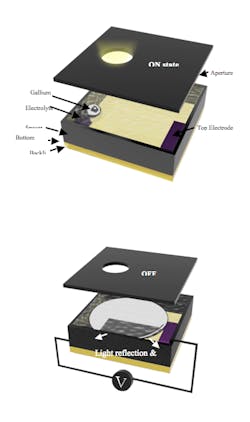ELECTROFLUIDIC DISPLAYS: Liquid-gallium light valve is fast, high-contrast

With decades of development resulting in long life and beautiful, high-resolution imaging, the backlit liquid-crystal display (LCD) has the ruling position in the laptop-computer market, and dominates the television market as well. However, the transmission efficiency within an LCD pixel's active area is typically on the order of only 7%.
Squashing a sphere
In contrast, researchers at Tatung University and National Taiwan University (both in Taipei, Taiwan) have built a single-pixel prototype of a different kind of backlit display, one that has a backlight efficiency of 96%. The display pixel relies on the electrowetting effect, in which a liquid droplet can be moved or reshaped by applying a voltage that alters the liquid's wetting contact angle. While other displays have used the movement of oils or pigmented fluids to alter the colors of pixels, the Taiwanese team uses liquid gallium (Ga), which, being a metal, is opaque and serves as an "on-off" valve for light that does not rely on polarizers or other transmission-reducing components.1
When a metal contacts an electrolyte, ions are transferred from the electrolyte, forming a capacitive layer that stores or releases energy, depending on the sign of the applied electric field. The researchers submerged a 2.1-mm-diameter Ga droplet in a cell filled with transparent electrolyte (200 ml of 5 M hydrochloric acid) such that the Ga droplet could be made by varying an applied voltage (a maximum of 0.85 V) to either be rounded and nonblocking, or become a flat 5.2-mm-diameter disk that blocked the pixel's entire active area (see figure).
The pixel was defined by two pieces of glass coated with transparent indium tin oxide, with a plastic spacer forming a 1 × 2 mm2 cell. A 0.8-mm-diameter aperture on top of the device outlined the active pixel area; an incandescent lamp served as the light source. The device had a 0.3 V threshold, no hysteresis, and a contrast ratio of 106:1. The researchers tested the pixel with a spectrometer and found no significant spectral influence on the transmitted light. The 96% transmission was based on the amount of light passing through the pixel in its on state divided by the amount of light passing through the bare pinhole (with the rest of the device removed).
Fast response
The researchers also tested the response time, using a 10 mW helium-neon laser at 633 nm as a light source. They drove the pixel with a 100 Hz square-wave signal and measured the output with a laser power meter, visualizing the output on an oscilloscope. The pixel had a 10% to 90% response time of 0.49 ms; the intermediate optical states were stable, indicating that grayscale states can be achieved.
Gallium melts at 29.7°C—just above room temperature. For this reason, the device was operated at 37°C. The researchers decided to use Ga instead of mercury (which is liquid at room temperature and below) due to the toxicity of mercury, according to Jeff Tsai, one of the researchers and the director of Tatung University's Graduate Institute of Electro-Optical Engineering. Interestingly, a metal alloy called Galinstan (68.5% Ga, 21.5% indium, and 10% tin), made by Geratherm Medical (Geschwenda, Germany) has a much lower melting point of -19°C (Galinstan has been used in medical thermometers) and is a possible replacement metal.
"We are currently working on a 16 × 8 pixel mini-display; the pixel size will be 0.5 × 1.5 mm2," says Tsai. "Although these are larger than the pixels in a conventional display, we are interested in proving the principle of this concept for display fabrication." The researchers foresee use of this fast, high-contrast light valve in other electro-optic devices as well.
REFERENCE
- Jeff T.H. Tsai et al., Appl. Phys. Lett. 95, p. 251110 (2009).

John Wallace | Senior Technical Editor (1998-2022)
John Wallace was with Laser Focus World for nearly 25 years, retiring in late June 2022. He obtained a bachelor's degree in mechanical engineering and physics at Rutgers University and a master's in optical engineering at the University of Rochester. Before becoming an editor, John worked as an engineer at RCA, Exxon, Eastman Kodak, and GCA Corporation.